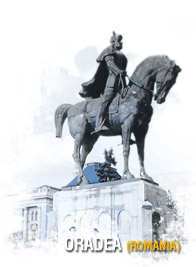 |
ORADEA (Romania)
Hotel Continental Oradea
Oradea is the capital city of Bihor County, in Crișana, Romania. The city proper has a population of 206,614 as of 2002 census; this does not include areas from the metropolitan area, outside the municipality; they bring the total urban area population to approximately 240,000. Oradea is one of the most prosperous cities of Romania.
The city lies at the meeting point of the Crișana plain and the Crișul Repede's basin. It is situated 126 meters above sea-level, surrounded on the north-eastern part by the hills of Oradea belonging to the Ses hills. The main part of the settlement is situated on the floodplain and on the terraces situated down the river Crișul Repede. Oradea is famous for its thermal springs. The river Crișul Repede crosses the city right in the centre, providing it with a picturesque beauty. Its output depends on the season; the water containers (the dyke near Tileagd) have partly controlled it ever since they were built in the early 1980s.
Between 1464 and 1667, the fortress of Oradea used to be the site for the first Prime Meridian in the world. It also housed the first astronomical observatory in Europe. In 1667 the Prime Meridian was moved to Nurnberg, Germany and later in 1882 to Greenwich, Great Britain, where it still is today.
Before 1848, Oradea was made up of 4 separate towns: Várad-Újváros (Villa Nova, former Vicus Zombathely), Várad-Olaszi (Villa Latinorum Varadiensium), Várad-Velence (Vicus Venetia), Várad-Váralja (Civitas Waradiensis). The names Vicus Venetia, Villa Latinorum, Vicus Bolognia, Vicus Padua and others refer to the French, Walloon, and Italian inhabitants who settled in the 13th century.
Today the city is made up of the following districts called quarters:
Centru Oradea (city centre); Nufărul; Rogerius; Velența; Ioșia; Ioșia Nord; Oncea; Salca; Seleuș; Vie; Iorga; Olosig; Episcopia Bihor
The quarter named Vie is also known as Podgoria. "Vie" and "podgorie" mean the same thing in Romanian, i.e. wine-growing estate.
The beautiful city centre is worth visiting, as are the Băile Felix health spas, accessible by train or bus and located outside the city.
Other sites worth visiting are:
- Muzeul Țării Crișurilor/Körösvidéki Múzeum – a wonderful Baroque museum with 365 famous windows. It was the Roman Catholic bishop's palace until 1945, when the Communist regime took the building into public ownership. It was returned to the Roman Catholic church in 2003. Its The view of the city center in the winter of 2006 collection includes many fossils of dinosaurs and birds from the bauxite mines at Cornet-Brusturi.
- Catedrala barocă/Székesegyház – the biggest Baroque cathedral in Romania
- Cetatea Oradea/ Vár - Oradea's Fortress, with a pentagonal fort
- Biserica cu Lună/ Holdas templom – a church unique in Europe, with a type of astronomical clock depicting the phases of the moon
- Pasajul "Vulturul Negru"/Fekete Sas – the "Black Eagle" Passage
- "Ady Endre" Museum- a museum dedicated to one of the greatest Hungarian poets
- Teatrul de Stat/Állami Színház – the State Theatre, plans for which were designed by two Austrian architects who had built around 100 theatres and opera houses in Europe by the end of the 19th century.
- Str. Republicii, known to the locals as "Principala" or "Fő utca" (Main Street) – one of the most beautiful streets of Transylvania, displaying an incredible number of Sezession buildings (under restoration in 2006).
- There are around 100 religious sites of different denominations in Oradea, including three synagogues (however, only one is said to be still in use) and the biggest Baptist church in Eastern Europe.
>> click here to visit the homepage of Oradea |
|